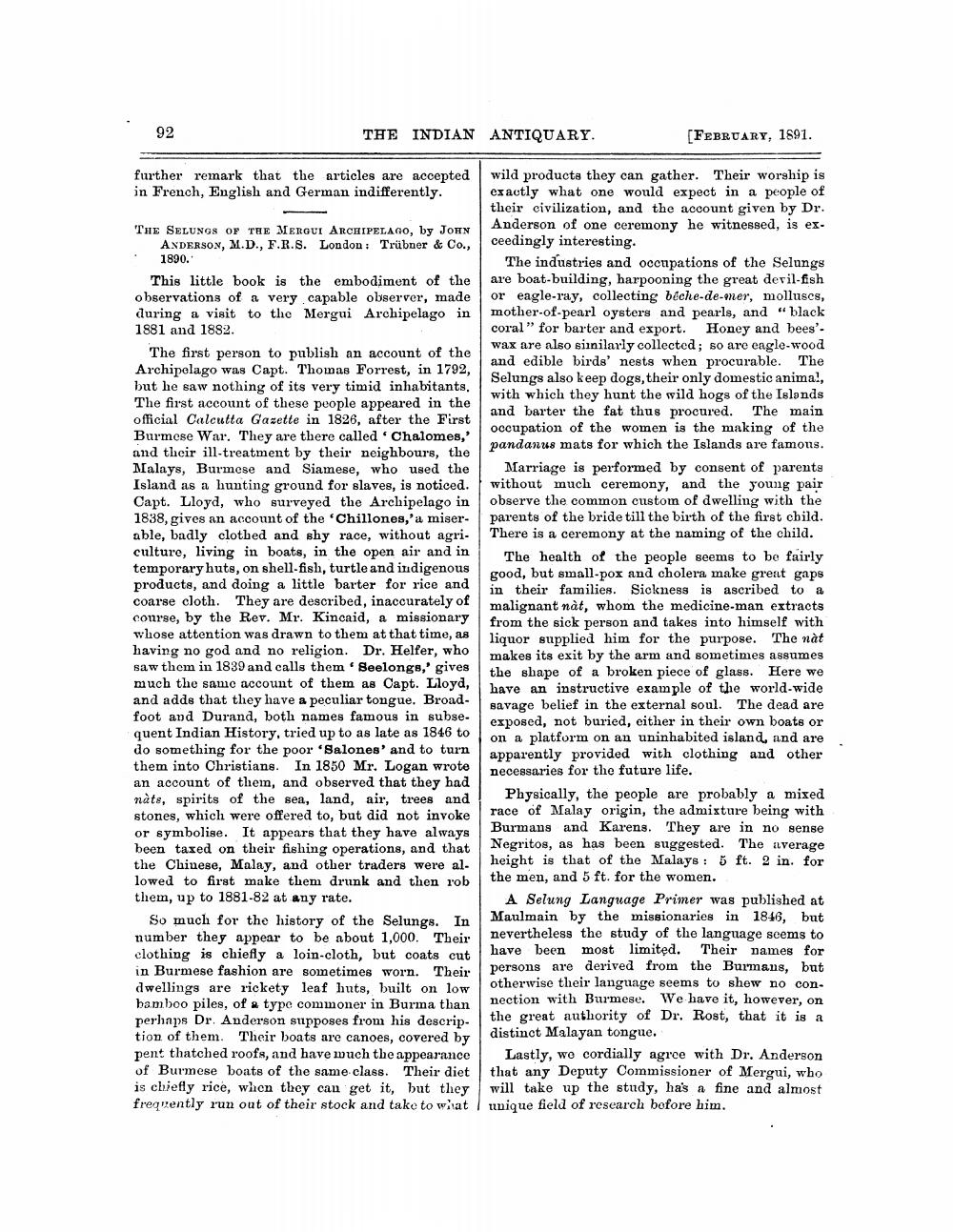________________
92
THE INDIAN ANTIQUARY.
[FEBRUARY, 1891.
further remark that the articles are accepted wild products they can gather. Their worship is in French, English and German indifferently. exactly what one would expect in a people of
their civilization, and the account given by Dr. THE SELUNGS OF THE MERGUT ARCHIPELAGO, by JOHN
Anderson of one ceremony he witnessed, is exANDERSON, M.D., F.R.S. London: Trübner & Co., ceedingly interesting. 1890.
The industries and occupations of the Selungs This little book is the embodiment of the are boat-building, harpooning the great devil-fish observations of a very capable observer, made or eagle-ray, collecting bêche-de-mer, molluscs, during a visit to the Mergui Archipelago in mother-of-pearl oysters and pearls, and "black 1881 and 1892.
coral" for barter and export. Honey and bees'. The first person to publish an account of the
wax are also sinilarly collected; so are eagle-wood
and edible birds' nests when procurable. The Archipelago was Capt. Thomas Forrest, in 1792,
Selungs also keep dogs, their only domestic animal, but he saw nothing of its very timid inhabitants.
with which they hunt the wild hogs of the Islonds The first account of these people appeared in the
and barter the fat thus procured. The main official Calcutta Gazette in 1826, after the First Burmese War. They are there called 'Chalomes,'
occupation of the women is the making of the and their ill-treatment by their neighbours, the
pandanus mats for which the Islands are famous. Malays, Burmese and Siamese, who used the Marriage is performed by consent of parents Island as a hunting ground for slaves, is noticed. without much ceremony, and the young pair Capt. Lloyd, who surveyed the Archipelago in observe the common custom of dwelling with the 1838, gives an account of the 'Chillones, a miser- parents of the bride till the birth of the first child. able, badly clothed and shy race, without agri. There is a ceremony at the naming of the child. culture, living in boats, in the open air and in
The health of the people seems to be fairly temporary huts, on shell-fish, turtle and indigenous
good, but small-pox and cholera make great gaps products, and doing a little barter for rice and
in their families. Sickness is ascribed to a coarse cloth. They are described, inaccurately of
malignant nåt, whom the medicine-man extracts course, by the Rev. Mr. Kincaid, a missionary
from the sick person and takes into himself with whose attention was drawn to them at that time, as
liquor supplied him for the purpose. The nat having no god and no religion. Dr. Helfer, who
makes its exit by the arm and sometimes assumes saw them in 1839 and calls them' Seelongs,' gives
the shape of a broken piece of glass. Here we much the same account of them as Capt. Lloyd,
have an instructive example of the world wide and adds that they have a peculiar tongue. Broad
savage belief in the external soul. The dead are foot and Durand, both names famous in subse
exposed, not buried, either in their own boats or quent Indian History, tried up to as late as 1846 to
on a platform on an uninhabited island, and are do something for the poor 'Salones' and to turn
apparently provided with clothing and other them into Christians. In 1850 Mr. Logan wrote
necessaries for the future life. an account of them, and observed that they had nàte, spirits of the sea, land, air, trees and
Physically, the people are probably a mixed stones, which were offered to, but did not invoke
race of Malay origin, the admixture being with or symbolise. It appears that they have always
Burmans and Karens. They are in no sense been taxed on their fishing operations, and that
Negritos, as has been suggested. The average the Chinese, Malay, and other traders were al. height is that of the Malays : 5 ft. 2 in. for lowed to first make them drunk and then rob
the men, and 5 ft. for the women. them, up to 1881-82 at any rate.
A Selung Language Primer was published at So much for the history of the Selungs. In
Maulmain by the missionaries in 1846, but number they appear to be about 1,000. Their nevertheless the study of the language seems to clothing is chiefly a loin-cloth, but coats cut have been most limited. Their names for in Burmese fashion are sometimes worn. Their
won ho
person
persons are derived from the Burmans, but dwellings are rickety leaf huts, built on low
otherwise their language seems to shew no con. bamboo piles, of a type commoner in Burma than
nection with Burmese. We have it, however, on perhaps Dr. Anderson supposes from his descrip
the great authority of Dr. Rost, that it is a tion of them. Their boats are canoes, covered by
distinct Malayan tongue. pent thatched roofs, and have much the appearance Lastly, wo cordially agree with Dr. Anderson of Burmese boats of the same class. Their diet that any Deputy Commissioner of Mergui, who is chiefly rice, when they can get it, but they will take up the study, has a fine and almost frequently run out of their stock and take to wiat unique field of research before him.




